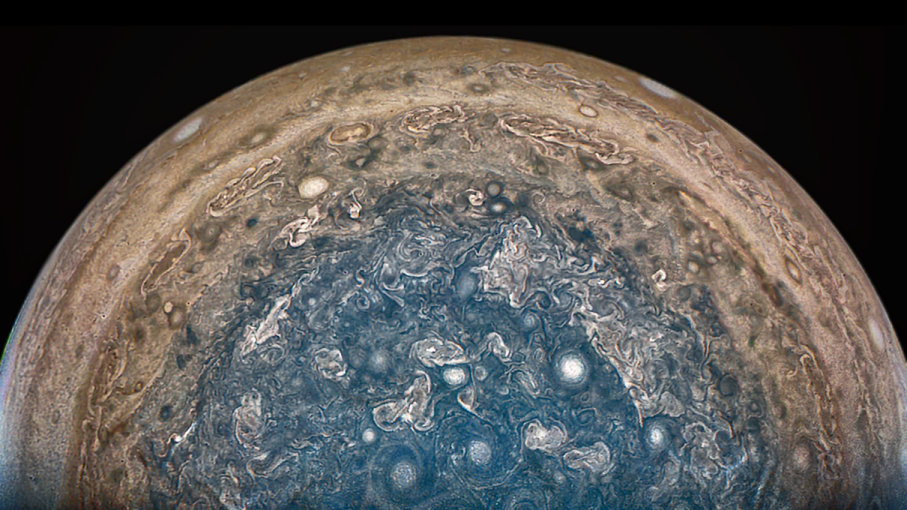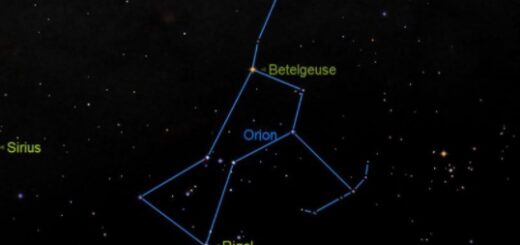New Juno Data Reveals Jupiter Is Much More Complicated Than Expected

NASA’s Juno spacecraft, which reached the planet Jupiter in July 2016 after a five-year, 1.7-billion-mile (2.7-billion-kilometer) journey, is exploring our solar system’s biggest planet. It’s taking advantage of a polar orbit that allows it to swoop down within 3,100 miles (4,990 kilometers) of the immense world’s cloud tops. Imagine it this way: If Jupiter were the size of a basketball, Juno would be only about a third of an inch away.
That’s the closest that any spacecraft has gotten to the immense planet without smashing into it, and it’s a chance to take a more detailed look than ever before possible at an immense, faraway object. And as scientists analyze the initial data from the $1.13 billion mission, they’re discovering that the gas giant appears to be significantly different than anyone would have imagined.
jupiter image from juno spacecraft
This view of Jupiter highlights the planet’s Oval BA cloud formation.
NASA/SWRI/MSSS/GERALD EICHSTÄDT/SEÁN DORAN
“Jupiter is not as simple as we thought it was,” says Scott Bolton, a scientist at the Southwest Research Institute (SWRI) who is Juno’s principal investigator. He describes the planet as having much more structure, variability and motion than scientists had envisioned. “Nobody expected Jupiter to have so much complexity, [and] so deep.”
As this SWRI press release details, Juno has eight scientific instruments designed to study the planet’s magnetic field, atmosphere and interior structure, and they show that Jupiter is far more than just a giant ball of gases.
“Until Juno’s arrival, our understanding of Jupiter’s atmosphere was based on what we can see from the side, near the equator,” says Steven M. Levin, a Juno project scientist at NASA’s Jet Propulsion Laboratory, in an email. “From that angle, Jupiter appears dynamic, but organized. Large belts and zones form a consistent pattern of jet streams which give the planet its familiar striped appearance. The new polar images from Juno look nothing like that. Around the poles, Jupiter looks chaotic, without an obvious, stable structure, and certainly without the regular stripes we see near the equator.”
“We don’t really know what this means yet,” Levin says. “It could tell us something important about how Jupiter’s atmosphere circulates, about how the great depth of Jupiter’s atmosphere affects its weather patterns, or about how the heat escapes from Jupiter’s interior. ”
Juno’s observations also show that at Jupiter’s equator, the planet has a narrow, ammonia-rich plume, which resembles a bigger version of the air currents rising from Earth’s equator to generate the trade winds.
jupiter image from juno spacecraft
A storm swirls just south of one of the more prominent white oval storms on Jupiter.
NASA/JPL-CALTECH/SWRI/MSSS/BETSY ASHER HALL/GERVASIO ROBLES
Additionally, as this NASA press release details, Juno’s observations reveal that Jupiter’s magnetic field — already known to be the most intense in the solar system — is even stronger than previously estimated, and uneven, with lumpy areas of relative strength and weakness. Bolton says that data, coupled with measurements of the planet’s gravity field, differing from projections points toward a planet whose interior has more complexity and motion than anyone would have expected.
jupiter image from juno spacecraft
Juno collected the first image of Jupiter’s ring taken from the inside looking out. The bright bands in the center of the image are the main ring in the planet’s ring system. The image is in the direction of the Orion constellation; the bright central star is Betelgeuse, and Orion’s belt is visible in the lower right.
NASA/JPL-CALTECH/SWRI
“The magnetic field does that at a higher level in the atmosphere, but the gravity field tells us that it’s going on a lot deeper, in the middle of the planet, or even deeper than that,” Bolton says.
“Our first magnetic field results suggest a magnetic dynamo region which is closer to the surface of the planet than anyone predicted, and perhaps more complicated than expected as well,” Levin explains. “The first gravity measurements suggest the possibility of deep winds, reaching thousands of kilometers into the planet, and/or a central core which is larger and less distinct than expected.”
Both Bolton and Levin say that the initial data already suggests that scientists may have to rethink their previous notions not just about Jupiter, but about how other gas giants work. They expect more insights to come from the information gathered by the satellite as it passes over Jupiter every 53 days, in a mission that Bolton says may go on for another three years.
“Along with the microwave radiometer measurements, which have also shown surprises in the deep atmosphere, these results demonstrate that if we want to understand giant planets, we will need to study all of Jupiter,” Levin says. “That means from the top of its atmosphere all the way to the core at its center, from the north pole to the south pole and everything in between, and across the longitudes all around the planet. That’s Juno’s mission, and we’re off to a fascinating start.”



 Creators of mankind
Creators of mankind Description of “Tall white aliens”
Description of “Tall white aliens” Where they came from?
Where they came from? About hostile civilizations
About hostile civilizations The war for the Earth
The war for the Earth “Tall white aliens” about eternal life
“Tall white aliens” about eternal life Video: “Nordic aliens”
Video: “Nordic aliens” Aliens
Aliens Alien encounters
Alien encounters The aliens base
The aliens base UFO
UFO Technology UFO
Technology UFO Underground civilization
Underground civilization Ancient alien artifacts
Ancient alien artifacts Military and UFO
Military and UFO Mysteries and hypotheses
Mysteries and hypotheses Scientific facts
Scientific facts


















